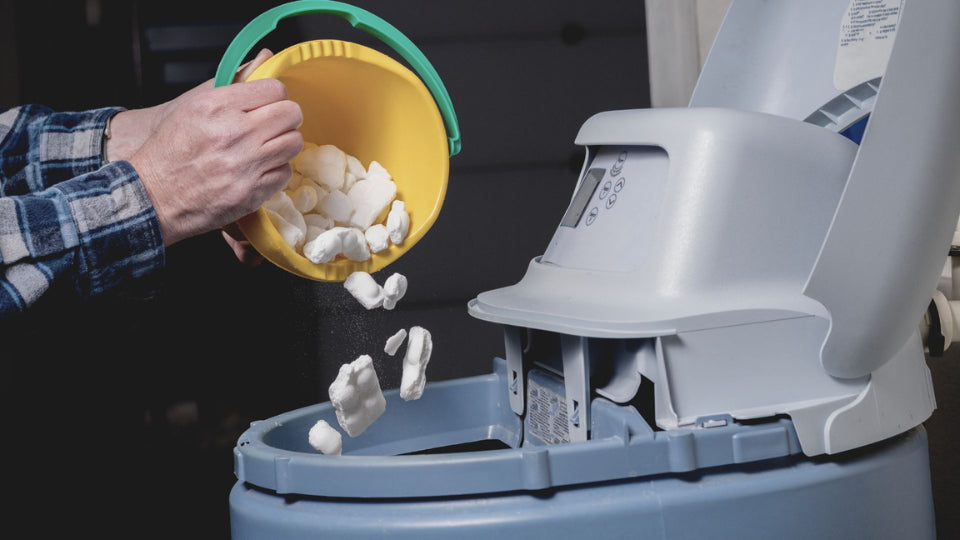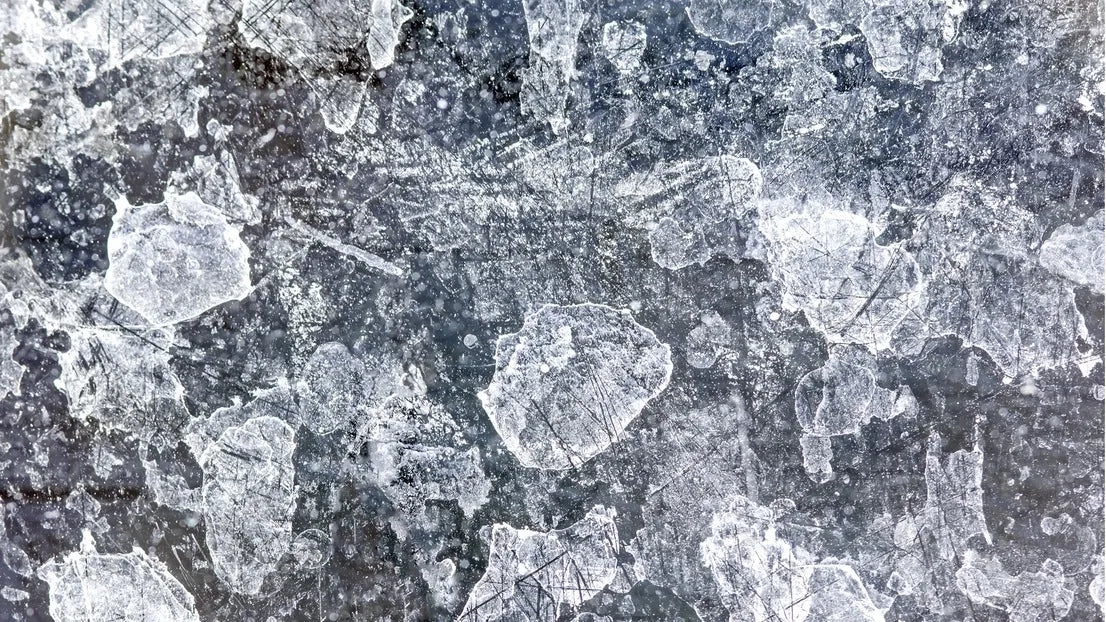Eine Wasserenthärtungsanlage auf Basis des Ionenaustauschs liefert weiches Wasser für einen Haushalt sowie dessen Geräte. Durch die Entkalkung des Trinkwassers wird der Härtegrad reduziert. Dies führt zur sogenannten Wasserenthärtung. Die Vorteile: Weniger Verkalkung und Schutz der Lebensdauer von Haushaltsgeräten. Was viele jedoch nicht wissen ist, dass solche Enthärtungsanlagen bzw. Entkalkungsanlagen mit Salz auch Nachteile mit sich bringen. Vor der Anschaffung einer Enthärtungsanlage ist es daher sinnvoll, diese Nachteile zu kennen. Der folgende Text erklärt verständlich, welche Nachteile eine Enthärtungsanlage aufweist und welche Alternative es für Hausbewohner gibt.

Bild: Herkömmliche Enthärtungsanlagen benötigen Regeneriersalz und sind wartungsintensiv
Wasserenthärtungsanlage – Nachteile kompakt zusammengefasst
- Entzug der Mineralstoffe Calcium und Magnesium aus dem Trinkwasser
- Wasserenthärtung mit Salz führt zur Erhöhung des Natriumwertes im Trinkwasser
- Gefahr vor Verkeimung des Trinkwassers bei längeren Stillstandzeiten
- Erhöhung der Metallaggressivität von Wasser und damit Erhöhung des Risikos vor Korrosion
- Eine Entkalkungsanlage mit Salz belastet die Umwelt durch Chlorid im Abwasser
- Erhöhter Wasserverbrauch durch Regenerationsvorgänge
- Laufende Kosten durch Salzverbrauch und Wartung
Wasserenthärtungsanlage Nachteil #1: Auswirkungen auf die Trinkwasserqualität: Mineralien raus – Natrium rein
Eine Wasserenthärtungsanlage auf Basis des Ionenaustauschs führt zu einer Veränderung der Trinkwasserqualität, wie sie von örtlichen Trinkwasserversorgungsunternehmen eingespeist wird. Die Wasserhärte bzw. der Kalk im Wasser besteht zum größten Teil aus den Mineralstoffen Calcium und Magnesium. Hartes Wasser enthält besonders viele dieser Mineralien. Eine Enthärtungsanlage tauscht diese Calcium- und Magnesium-Ionen gegen Natrium aus. Dadurch kommt es zu einem Anstieg des Natriumwertes. Dies ist auch der Grund, warum regelmäßig Salz in den Vorratsbehälter der Enthärtungsanlage nachgefüllt werden muss. Aus ernährungswissenschaftlicher Sicht kann diese Entfernung von Mineralstoffen aus dem Trinkwasser unerwünscht sein (1). Gerade beim Kauf von Mineralwasser wird häufig auf die Qualität des jeweiligen Mineralwassers mit Begriffen wie „Reich an Magnesium und Calcium“ oder „Natriumarm – geeignet für die Zubereitung von Babynahrung“ hingewiesen. Ein Ionenaustauscher führt jedoch zu einer gegenteiligen Trinkwasserqualität. Der Anstieg des Natriumwertes durch die Verwendung einer Enthärtungsanlage verdient besondere Aufmerksamkeit, wenn das Wasser anschließend zur Zubereitung von Säuglingsnahrung verwendet wird. Ist die ursprüngliche Wasserhärte oder der Natriumwert im Wasser bereits sehr hoch, kann es außerdem zu einer Grenzwertüberschreitung des Natriumwertes von 200mg/l gemäß der Trinkwasserverordnung kommen (2).
Wasserenthärtungsanlage Nachteil #2: kein Kalk, aber dafür Rost in der Trinkwasserinstallation
Weiches bzw. enthärtetes Wasser hat nicht nur Vorteile. Enthärtungsanlagen mittels Ionenaustausch haben den Nachteil, dass diese zu einer grundlegenden Änderung des korrosionschemischen Verhaltens eines Wassers führen, wodurch das Wasser metallaggressiv wirken kann. Dies liegt daran, dass Enthärtungsanlagen das sogenannte Kalk-Kohlensäure-Gleichgewicht eines Leitungswassers stören. Durch die Verwendung von Wasserenthärtungsanlagen entsteht „überschüssige“ Kohlensäure, welche langfristig das Metall der Haushaltsgeräte und Wasserleitungen angreifen kann und somit zu Schäden in einer Trinkwasserinstallation führen kann, z. B. durch Lochfraß. Um dieser Metallaggressivität vorzubeugen, wird das Wasser einer Enthärtungsanlage in der Regel mit unbehandeltem Wasser „verschnitten“ und teilweise sogar mit sogenannten Inhibitoren (z. B. Phosphaten) nachbehandelt. In diesem Zusammenhang wird darauf hingewiesen, dass eine unzureichende Nachbehandlung des weichen Wassers die häufigste Ursache für Korrosionsschäden in Haushalten mit Enthärtungsanlagen ist. (3)
Wasserenthärtungsanlage Nachteil #3: Gefahr von Bakterien im Trinkwasser durch eine Wasserenthärtungsanlage
Ein weiterer Nachteil einer Enthärtungsanlage bzw. Entkalkungsanlage mit Salz ist das Risiko der Verkeimung des Leitungswassers. Kommt es zu längeren Verweilzeiten des Trinkwassers im Austauscherharz des Ionenaustauschers, muss mit einer vermehrten Keimbelastung gerechnet werden. Bei Anlagen mit längeren Standzeiten ist daher darauf zu achten, dass bei der Regeneration des Ionentauscherharzes einer Enthärtungsanlage eine Desinfektion dieses Harzes erfolgt (4).
Wasserenthärtungsanlage Nachteil #4: Chlorid im Abwasser einer Enthärtungsanlage schädigt die Umwelt
Enthärtungsanlagen haben nicht nur technische Nachteile, sondern auch Nachteile für die Umwelt. Durch die Nutzung von Ionenaustauschern gelangen hohe Mengen an Natrium und Chlorid in das Abwasser. Dadurch kann die Belastung durch Chlorid in einem Versorgungsgebiet signifikant steigen (5). Durch die Wasserlöslichkeit von Chlor, können die Chlormengen durch kommunale Kläranlagen nicht entfernt werden (6). Die Folge wäre ein stetiger Anstieg der Chlorbelastungen in Gewässern.
Auf eine Anfrage des Abgeordneten Hendrik Lange zur Chlorbelastung in deutschen Gewässern entgegnete die Landesregierung Sachen-Anhalts 2016 folgendes: „Bei Abweichungen fallen empfindliche Arten aus, robuste Arten breiten sich aus. Das gesamte Arten- und Abundanzgefüge einer Lebensgemeinschaft kann sich dadurch verändern (7). Aus diesem Grund gibt es z. B. in Kalifornien wegen zu hoher Chlorid-Werte im Abwasser bereits ein Gesetz (Senate Bill 475) (8), dass es lokalen Behörden ermöglicht, die Verwendung von bestimmten Ionenaustauschern für private Zwecke zu verbieten (9).
Wasserenthärtungsanlage Nachteil #5: erhöhter Wasserverbrauch durch Regenerationsvorgänge
Ein weiterer Nachteil einer Entkalkungsanlage mit Salz (Ionenaustauscher) entsteht durch den zusätzlichen Wasserverbrauch für Regenerationsvorgänge. Ein Wasserenthärter kann je nach Größe immer nur eine bestimmte Menge an Trinkwasser enthärten. Ist diese Menge erreicht, muss er regeneriert werden. Dies bedeutet, dass das Ionenaustauscherharz in bestimmten Abständen mit Wasser gespült und mit neuer Natriumchlorid-Lösung „beladen“ wird. Für diesen Prozess werden viele Liter Wasser benötigt. Für ein Einfamilienhaus mit drei bis vier Personen, welches in einer Region mit hartem Wasser liegt, kann dies in manchen Fällen einen zusätzlichen jährlichen Wasserverbrauch von bis zu mehreren tausend Litern Wasser bedeuten.
Wasserenthärtungsanlage Nachteil #6: weiches Wasser, aber kein kalkfreies Wasser!
Enthärtungsanlagen bzw. Entkalkungsanlagen mit Salz werden häufig auch als Weichwasseranlagen bezeichnet. Zwar liefern diese Anlagen weiches Wasser, aber kein vollkommen „kalkfreies“ Wasser. Aus den oben genannten Gründen der Gefahr vor Korrosion wird das enthärtete Wasser immer mit unbehandeltem Wasser verschnitten. Häufig belassen Wasserenthärtungsanlagen auf Basis des Ionenaustauschs eine Restwasserhärte von 4 °dH – 8 °dH im Wasser. Ein Haushalt reduziert durch den geringeren Härtegrad definitiv Kalkablagerungen. Zu erwarten, dass man nie wieder „Kalkflecken“, also Ablagerungen, auf einer Oberfläche wie Armaturen oder einer Glasdusche vorfindet, wäre jedoch falsch. Eine Wasserenthärtung bzw. Entkalkung des Wassers auf eine Wasserhärte von 0°dH ist nicht üblich.
Wasserenthärtungsanlage Nachteil #7: eine Wasserenthärtungsanlage verursacht nicht nur Anschaffungskosten
Kosten einer Wasserenthärtungsanlage entstehen nicht nur bei ihrer Anschaffung und Installation. Für den Betrieb eines Ionenaustauschers muss regelmäßig Salz angeschafft und nachgefüllt werden. Ein weiterer, nicht zu vernachlässigender Kostenpunkt ist die Wartung einer Enthärtungsanlage. Die DIN EN 806-5 empfiehlt eine Wartung alle sechs Monate. Davon sollte mindestens einmal im Jahr diese Wartung durch ein Fachunternehmen erfolgen. Viele Hersteller bieten hierfür spezielle Wartungsverträge an.
Die Alternative: Wie wäre es mit einer innovativen Kalkschutzanlage anstatt einer Enthärtungsanlage mit Salz?
Der Einsatz einer Wasserenthärtungsanlage hat mehrere Nachteile. Insbesondere die Auswirkungen auf die Trinkwasserqualität und die Umwelt sind nicht zu vernachlässigen. Als Alternative für eine Wasserenthärtungsanlage mit Salz gibt es bereits seit mehreren Jahren sogenannte Kalkschutzanlagen. Der bedeutende Vorteil einer Enthärtungsanlage ohne Salz ist, dass die Mineralstoffe Kalzium und Magnesium im Trinkwasser enthalten bleiben. Es wird außerdem kein Natrium dem Trinkwasser hinzugegeben. Stattdessen bedeutet „Kalkschutz“, dass sogenannte Impfkristalle gebildet werden, an denen sich der Kalk im Wasser festsetzt. Diese mikroskopisch kleinen Kalkkristalle lagern sich nicht mehr an Oberflächen ab, sondern werden bei jeder Wasserentnahme ausgeschwemmt. Kalkschutzanlagen sind daher von besonderem Interesse für Hausbesitzer, die ihre Trinkwasserqualität erhalten wollen. Kalkschutzanlagen erhöhen zudem nicht das Risiko von Korrosion.
AQON PURE: Die Innovation ohne Salz
Sie sind auf der Suche nach einer Lösung für hartes Wasser? Sie möchten Kalkablagerungen reduzieren? AQON PURE ist eine umweltfreundliche Kalkschutzanlage, welche die wertvollen Mineralien Calcium und Magnesium im Trinkwasser belässt und keine laufenden Kosten verursacht. AQON PURE Kalkschutzanlagen gibt es sogar mit Einbauservice zum Festpreis und 1 Jahr Geld-zurück-Garantie.






